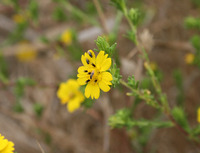Annuals, subshrubs, or shrubs, 4-120(-150) cm. Stems usually ± erect, rarely decumbent. Leaves mostly cauline (annuals forming winter-spring rosettes, usually withering by flowering); proximal opposite, most alternate; sessile; blades oblanceolate to linear or lance-linear, usually pinnatifid or toothed, sometimes serrate or entire, faces often hirsute or hispid-hirsute, sometimes villous, pilose, pubescent, canescent, strigose, or scabrous (often sessile- or stipitate-glandular as well) or glabrous (with scabrous or hispid margins). Heads radiate, usually in corymbiform or ± paniculiform arrays, sometimes in racemiform arrays or in glomerules. Peduncular bracts: pit-glands, tack-glands, and spines 0. Involucres ± obconic, campanulate, hemispheric, or urceolate, 2 -13+ mm diam. Phyllaries falling, 3-35 in 1 series (± lanceolate to lance-attenuate or oblanceolate, herbaceous, each usually 1/2 enveloping subtended ray floret proximally, abaxially ± hirsute and sessile- or stipitate-glandular). Receptacles flat to convex, glabrous or setulose, paleate (paleae falling, in 1 series between rays and disc in annuals, in 2-3+ series or subtending all or most disc florets in subshrubs and shrubs, connate or distinct, phyllary-like, more scarious). Ray florets 3-35, pistillate, fertile; corollas deep or pale yellow. Disc florets 3-70, usually functionally staminate, seldom bisexual and fertile; corollas yellow, tubes shorter than or about equaling funnelform throats, lobes 5, deltate (anthers usually reddish to dark purple or yellow, rarely maroon; styles glabrous proximal to branches). Ray cypselae slightly obcompressed (adaxial sides flatter than abaxials), clavate (abaxially gibbous, often ± arcuate, basal attachments oblique, apices ± beaked, beaks offset adaxially, ascending, faces glabrous); pappi 0. Disc cypselae usually 0; pappi (of disc florets) usually of 1-15 elliptic, lance-linear, lanceolate, linear, oblong, quadrate, setiform, or subulate, entire, erose, fimbriate, fringed, or laciniate scales, sometimes 0 or coroniform (crowns of ± linear, sometimes fimbriate scales). x = 12 or 13.





